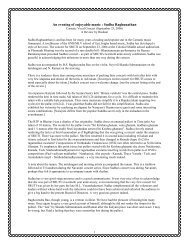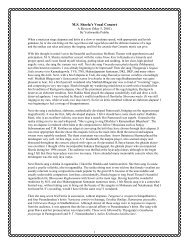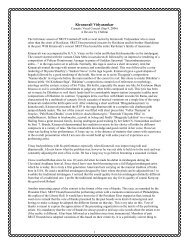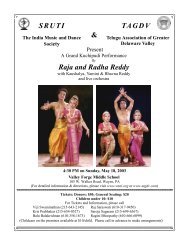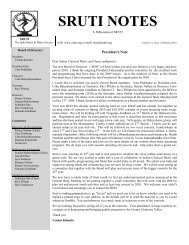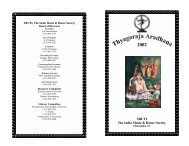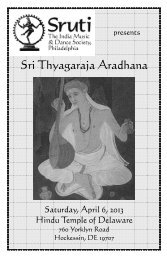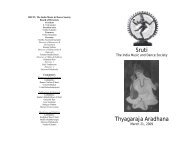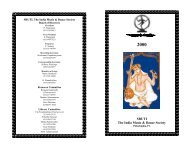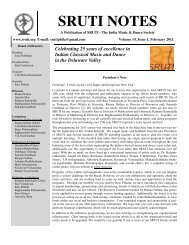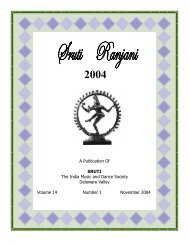SrutiNotes_Jun2006_ver4 (Final)
SrutiNotes_Jun2006_ver4 (Final)
SrutiNotes_Jun2006_ver4 (Final)
- No tags were found...
You also want an ePaper? Increase the reach of your titles
YUMPU automatically turns print PDFs into web optimized ePapers that Google loves.
SRUTI NOTESBOARD OF DIRECTORSPresidentUsha Balasubramanian215-699-2827President-electRamana Kanumalla610-277-8955TreasurerVenkat Kilambi610-631-2291SecretarySujatha Patri215-672-4365Director of Resources &DevelopmentUma Prabhakar215-616-0486Director of Publications &OutreachRaman Visweswaran610-647-7822Director of Marketing &PublicityJeya Sankaran610-279-3655Director 1Ponnal Nambi610-647-7235Director 2Ravi Pillutla610-539-8686COMMITTEESResources & DevelopmentCommittee:Uma Prabhakar (Chair)215-616-0486Rama Gundurao215-591-0380Ramaa Nathan610-668-3691Ramana Kanumalla610-277-8955Venkat Kilambi610-631-2291Publications & OutreachCommittee:Raman Visweswaran (Chair)610-647-7822Sundari Balakrishnan610-358-1673Rangaprabhu Parthasarathy781-964-8118Ramaa Nathan610-668-3691Rungun NathanWeb: http://www.sruti.orgEmail: sruti@sruti.orgA Publication of SRUTIThe India Music & Dance SocietyCelebrating Twenty years of service to the communityFrom the Editor’s Desk...Volume 9, Issue 2, June 2006The Thyagaraja Aradhana event of March 4 launched the spring season of the year for Sruti. Thegroup rendition of the Pancharatna Kritis led by Smt. Prabha Subramanyan, Smt. Sumathi Sarangan,and Smt. Sushila was as always in great form. It was heartwarming to see some newer faceson the stage. Each year, we witness the dedication that goes into the practice of Carnatic Music byparticipants at all levels at the individual level. It gives us great pleasure to be part of a communitythat encourages this dedication. The young participants mature as they graduate to Saint Thyagaraja’scompositions that offer greater challenge in ragas, talas and sangatis (variations). Seasonedpractitioners offer their rendition of selected Thyagaraja Kritis to the Saint’s memory. In addition,we celebrate the hard work put in by all the teachers in the area. The day culminated with a concertby Sri.B.Balasubrahmanyan, accompanied by Sri. K.S. Mani on the violin and Sri David Nelson onthe mrudangam.This edition of Sruti notes carries a number of reviews of concerts: Smt. Sowmya’s concert dedicatedto the memory Sri Sankaran, Smt.Vijayalakshmi Subramaniam’s concert which marked thelaunch of a Chamber Concert series, and the recent vocal concert by Ranjani and Gayatri. Sri Rasikan’sparable is thought provoking. We have included an article by Preeti Arunapuram, a youngCarnatic Music practitioner and enthusiast. She elaborates on her participation in the competitionorganized by the Cleveland Thyagaraja Aradhana Committee. Some notable events relevant to theworld of performing arts are also included in this edition.The Library committee would like to take this opportunity to request your thoughts on matters relatedto the performing arts and also notable community events. We would especially like to hearfrom young people. We request parents to encourage students or enthusiasts of music and dance toput their thoughts down on paper. Our spring season ended with a wonderful well-attended concertby Dr. Balamurali Krishna. We wish you all a great summer. This year is the 20th anniversaryyear of the founding of Sruti. The Board of Directors are continuing to work on events to mark theoccasion. Please stay tuned……The Library CommitteeThe opinions expressed by the contributors of articles and reviews are published in a spiritof openness of communication and freedom of expression. They do not necessarily reflect theviews of Sruti’s Board or its members.
President’s NoteDear FriendsThis is the twentieth anniversary of Sruti, and over the yearswe have evolved in to an esteemed presenting organization ofIndian classical music and dance. The expectations from theorganization by the members as well as visiting artists arerising and I thank the BOD and volunteers who are meetingthe challenge.The year started with the Thyagaraja Aradhana and eveningconcert was rendered by B.Balasubramaniyan from WesleyanUniversity. The quality of children’s rendition was verygood. Sruti collected a small registration fee from the participantsto cover the material cost involved.The Pancharatna Kritis singing group started the program.However, the size of the group is reduced to a handful ofpeople. The Utsava Sampradya Kritis group ceases to exist.Sruti has recruited couple of local teachers to teachPancharatna Kritis & Utsava Sampradya Kritis to add somenew faces to the group. Please contact the BOD if you areinterested.The spring season started with Sowmya’s vocal concert followedby a Mandolin duo concert by Shrinivas and Rajesh.We also had Ranjani & Gayatri Vocal concert in May. Thespring season ended with a vocal concert by Dr. BalamuraliKrishna. All these concerts were well received by the audienceand we are pleased with our spring concert season.We also introduced a new chamber style programs for limitedaudience. Our maiden Chamber concert was presented byVijayalakshmi Subramaniam and was a great success.Sruti is celebrating the 20th year anniversary throughout theyear by presenting quality programs by high caliber artistsand for the fall season we have a very exciting lineup. We arestarting with a vocal concert by Sudha Raghunathan on Sept23rd followed by a Bharathanatyam program by PriyadarshiniGovind on Oct 7th. On October 28th we are havingAnoushka shankar’s concert at Pearlman Theatre in collaborationwith Kimmel Center followed by a grand symphonicwork with South Indian ensemble and western classical orchestraby Jayamangala School of Music andDance,Washington DC on November 11th. The funding forsome of the above programs are provided by the PhiladelphiaMusic Project and Philadelphia Presenting Project.We look forward to seeing all of you for the upcomingevents. We thank you for your continued support throughoutthe year. Please feel free to send your feedback or any concernsyou may have to President@sruti.orgUsha BalasubramanianPresidentFor the Board of Directors, SrutiA ParableRasikanOnce there lived in a small village in the southern part ofIndia a simple man. Simple he was as a man but a giant ascomposer of classical music in the Carnatic idiom. He was agenius who composed songs mostly in praise of various deitiesincluding his Ishta Devatha, Sri Rama. They were calledkeertanas and/or kritis. Some of these were simple enoughthat they could be sung in bhajanas or utsavas by folks notparticularly adept in music but who enjoyed singing. A largepercentage of his oeuvre consisted of kritis which would requirea decent level of training in Carnatic music (CM).They consisted of kritis which were deceptively simple tohighly sophisticated and weighty ones requiring years to master.And then there were five (referred to as gems) which onlythe best trained artists could do justice to.And so it came to pass that over a period of time his famespread and people came from distant towns and villages notonly to hear these musical masterpieces but also to learn fromthe master himself. These disciples in turn taught the musicto others. After a time, other composers tried to emulate himand composed on their own, following the pattern set by him.However, it happened that CM remained essentially the musicas developed by the great man.And so it passed that after living a long simple material lifebut leaving a rich treasure of music, the man died. And hisyears were eighty.And the disciples and other admirers were forlorn, butvowed to continue his legacy. First in small groups and thenin ever increasing numbers, they visited the village where hehad lived and on the anniversary of his death performed aradhana.This included rendering of the wonderful keertanasand kritis composed by him. Then some people rememberedthe five gems and suggested that they should be rendered ingroup singing.And anyone who could sing or play on an instrument came topay their homage. And the novice and the highly talentedprofessional came and in humble reverence performed for afew minutes each and paid their respect to the master.And people donated generously to the organizers so anyonewho came for the celebration, the lowly or the rich, wasgiven free food.And thus grew the tradition of the annual celebration at thesite where his mortal remains were interred.And so it came to pass that a number of people from the areamoved to other parts of the country. Many of them also immigratedto England, Canada, Australia and the United Statesof America. But wherever they lived they remembered themusic created by the great composer. And they gatheredevery year at a time close to his death anniversary and performedaradhana.2
And so it came to pass that in the Diaspora, organizationssprouted up in London, Melbourne, Toronto, Cleveland andPhiladelphia and other cities. They propagated the rich musicallegacy left by the great master. And these organizationscelebrated the aradhana providing space for people whowanted to pay homage to the great soul and render the songsin singles or in groups. Children, young musicians and adultsprepared for the occasion and they all participated with enthusiasmmixed with reverence. And in keeping with thetradition in the native land the organizations provided freefood on the day of the aradhana.And so the great master, perched in his high place in theHeavens, looked at these celebrations which rememberedhim and honored his music. And he hailed his Ishta Devataand exclaimed, "Oh, Rasika Siromani, you made my nameand fame shine far and wide and in distant countries. Oh,Dasarathe, how could I ever repay my debt to you.”And he felt gratified and happy.And he shed a tear of joy.And so it came to pass that as the diasporas grew the organizationsrun almost completely by volunteers also grew. Andthey were praised for making it possible for the lovers of CMto come up every year and sing the kritis of the master andpay their homage.And he felt gratified and happy.And then it came to pass that as the organizations run almostcompletely by volunteers grew, and the number of participantsincreased, the organizations required that any one whowanted to perform must tell them ahead of time.And the financial burden also grew. So they started collectingdonations or charging for food.And then it came to pass that one organization run completelyby volunteers in a corner of the U.S. of A. decidedthat in order to perform at the aradhana one should not onlytell them ahead of time but also pay in order to perform.And so perched in his high place in the Heavens, the greatmaster looked down at this.And he introspected and exclaimed, “Oh, mind, tell me truly,does wealth produce pleasure?”And he felt a twinge of sadness.And he shed a tear.About the author: An ardent admirer and lover of Carnaticmusic, Rasikan has been a regular contributor to Sruti Notesand other publications of Sruti.Thyagaraja Experience in ClevelandPreeti ArunapuramThis year, I attended the annual Thyagaraja Aradhanafestival in Cleveland, Ohio. In addition to attending theconcerts, I also went there to participate in the carnatic vocalcompetition in a couple of categories. Although a bit nervous,I thoroughly enjoyed the competitions and I felt that it was awonderful experience for me. During the long car ride fromPhiladelphia to Cleveland, all I could think of was the competition.On the day of the competition, I kept practicing thesongs to myself, kept my fingers crossed and hoped that Iwould do well. I was very nervous! <strong>Final</strong>ly, we got to theplace and I felt so anxious that I could actually feel my kneestrembling. Before the competitions began, we were led into abig auditorium, where we listened to some speeches by theorganizers and renowned artists. One of the speeches was byDr. N. Ramani, the famous flutist. He said that he was proudto see us participating in the competition and getting exposedto Carnatic music. His kind words encouraged me and I wasreally in the mood to sing! We then waited for the competitionsto begin. They finally did and soon, I was outside practicingmy three songs over and over again to keep them ingood shape. For the competition, all the participants had toprepare three songs. The judges would choose one of thesongs for us to sing. Some time passed and I was asked to beprepared to sing because there were only two or three singersbefore it was my turn. Nervously, I stepped into the room,half-shyly and half-excitedly. I began to shiver with immenseexcitement. After listening to one of the participants, I becamemore anxious. She was so good! Something else struckme at the moment as well; I realized that I was going to besinging in front of a big artist that I enjoy listening to, NeyveliSanthanagopalan. It was such an honor to sing in front ofhim. However, this made me all the more tense. At last, myturn came and I sat down, poised to sing whatever the judgesasked me to sing. I was hoping that they wouldn’t pick thesong, Vidajalathura in raga Janaranjani, that I had the mosttrouble with; unfortunately, they picked that song. I started tosing. At first, my voice was a little shaky, but I managed tosing the best I could. But at last, I did finish, pleased that thesong actually came out much better that I used to sing it duringpractice. I stepped out of the room, encouraged by myperformance that I would also do well in the swarakalpanadivision of the competition as well. Unfortunately, while Iwas singing my swarakalpana in the raga Madyamavati, everythingwas going fine until I was distracted by a noise thatcame from outside the room. Nevertheless, I still thought thatI did okay and was happy with my performance. What anexciting day! The next day came and I got to enjoy a performanceby Sudha Raghunathan, one of my favorite artiststo listen to. Altogether, my trip was one that I will never forget.I know that I will return to Cleveland and continue to participatethere. Since I was a very little child, I have been inspiredby music. I used to listen to Sudha Raghunathan CD’s when Iwas only one year old and I used to try to sing along with therecording! My mother started teaching me some Carnaticmusic when I reached the age of four or five. At the age of3
eight, I started to learn Carnatic music from Mrs. Lata Sureshwho is in the West Chester area. I have enjoyed the experienceof learning from her and have been learning from herfor the past seven years. During the years that I have developeda love for Carnatic music and that love has been continuingto grow. Not only Carnatic music, but I have developedthe same kind of liking for western violin. My familyhas a very musical background and we all enjoy music in oureveryday lives. I am glad that I am learning Carnatic music; Ilike it very much!About the author: Preeti Arunapuram is a 8 th grade studentin the West Chester Area School District in Pennsylvania.Preeti has been learning Carnatic vocal Music fromMrs. Lata Suresh for over 5 years. She made several stageperformances in nearby temples and participated in severalcompetitions. She won first place in junior vocal competitionconducted by India Association of Performing Arts in NewJersey. She also plays Suzuki style violin and is a member ofher West Chester Area School Districtâ€s Select Stringorchestra. Besides music, Preeti loves reading and playingtennis.Vijayalakshmi SubramaniamChamber Music - A Review (Apr 22, 2006)RasikanUsha Bala, SRUTI President, stated that as an experiment,SRUTI has initiated chamber music concerts. The idea, if Icorrectly understood her remarks, is to invite a musician ofrepute to perform for a comparatively small audience in arather informal setting without sacrificing the classical contentof the program.In keeping with this objective, Vijayalakshmi Subramaniamgave a concert at the premises of J&B Software, Blue Bell onApril 22, 2006. She was accompanied by Gowri Ramakrishnanon the violin and Akshay Anathapadmanabhan on themridangam. Many in the audience sat on the floor almostwithin shake_hands distance from the artists yielding a veryinformal atmosphere.Vijayalakshmi Subramaniam has a very pleasant voice andwas in a good form. After a brisk Abogi varnam Evaribodhana, she sang Vinayaka in Hamsadwani, a veenai Kuppaiyerkriti in Adi talam. The neraval and swarams at Kalilorajasa in the charanam of Manasa yetulo (Malayamarutham,Rupakam, Thyagaraja) were crisply rendered. Vijayalakshmisang a good Varali alapana preceding Mamava Meenakshi,the Dikshitar kriti in Chapu talam.The next three pieces were rare or “not so often heard” kritis:Enda vidamakhilum, a Oothukadu Venkatakavi compositionin Kambhodhi, Adi; Sarasadala in Saramathy, Adi, HarikesanallurMuthiah Bhagavathar; and Gopalakrishna Bharathy’sEdo theriyamal in Hamir Kalyani, Rupakam.The central piece of the concert was Thyagaraja’s ever greenkriti in Mohanam, Nannu Palimpa.The post thani period included the Annamacharya piece, Garudagamana,in Hindolam, a Azvar pasuram, Pachai mamalai rendered as a viruttam in Nadanamakriya, Kapi, YamunaKalyani and Lalith ending up with a Kabir Das bhajanin Lalith.The concert concluded after a Purandara Dasa piece Thungain Neelambari and the Brindawani tillana of BalamuraliKrishna.It was an enjoyable concert made more so because of theclose interaction between the artists and the audience.S. SowmyaA Review (Apr 8, 2006)T. ParasaranThe concert was held in the Bharatiya Temple auditorium, onApril 8th, in memory of Mr. S. Sankaran, a staunch supporterand well wisher of Sruti. Since he was an ardent admirer ofCarnatic music, especially G.N. Balasubramanian (GNB)Sowmya dedicated the concert to both. She was accompaniedon the violin by R.K. Shriramkumar and on the mridangamby Neyveli Narayanan.The concert started off with the lively Kedaragowla Varnam,“Sami Daya Chuda” followed by the only kriti” Kalala Nerchina”in the Raga Deepakam by Sri Thyagaraja. After ashort Alapana in Asaveri, Sowmya sang Thyagaraja’s “Yepanikko Janma”. It was followed by Muthu Thandavar’s“Adikondar”. Next there was a nicely rendered Alapana inAndolika with the kriti, “Raga sudha” which set the tempofor the evening. After Kamas Raga and Purvi Kalyani shesang GNB’s “Nee charanambujamu” in Keervani. This wasan interesting piece.Though the start of Alapana in Kambodhi was rather tentative,Sowmya picked up a sincere elaboration of Ragam andTanam culminating in the pallavi, “Thillai eesanai”, a pallavimade popular by GNB. Shriramkumar’s violin rendering ofKambodhi Raga and the Thani of Neyveli were quite pleasing.The post pallavi pieces, “Vagaladi”, a javali in Behag, akirtana “ninnaye” in Sindhu Bhairavi, a Kavadi Chindu,“Chenni Nagara Vasan” and a Thillana rounded off the concertnicely.The acoustics in the hall was good for the most part butsometimes the instruments tended to be quite loud and occasionallyeven drowned the vocalist. In my opinion, a liveliermix of Thalams would have made the concert a memorableone. All the same it was an audience pleasing, well performedconcert.About the author: T.Parasaran is a retired chemist who isinterested in listening to all classical music forms and especiallyCarnatic music because of his origin from Tiruvarur!4
Ranjani & GayathriA Review (May 21, 2006)Yeshwant PrabhuRanjani and Gayatri started their concert with TiruvottiyurThyagayya's majestic varnam Chalamela in the raga Darbar.The clarity of their pronunciation of the sahitya of the kriti,their diction, and the smoothness of their rendition was extraordinaryfrom the beginning to the end. The violinist, H.N. Bhaskar, played very well; the smoothness of his bowingmatched the smoothness of the vocalists. The mridangist, K.Arun Prakash, played with restraint, contributing to an impressiveand flawless beginning. Next they sang MuthuswamiDikshitar's Swaminatha Paripalaya in the raga Nattai, withsuperb swaraprasthara in the end. The cascading notes flowedlike the torrential waters of the Niagara Falls. Although I wasa bit overwhelmed by the gush and speed of their swaras, itwas, nevertheless, very pleasant to hear. Next Ranjani sang abeautiful alapana in raga Chakravaka. It was methodical andwell developed. And she brought out the ragaswaroopa ofChakravaka smoothly and effortlessly, expounding the ragaand building the alapana with extraordinarily beautiful sangatis.The violinist rendered the alapana very well also. I mustsay that it is not easy to shine while playing for great singersof Ranjani and Gayatri's caliber. But Bhaskar managed toimpress with a smooth, flawless rendition. The sisters sangTyagaraja's kriti Sugunamule with bhaava in very appropriatemadhyama kaala. They sang kalpana swaras here also in theirtrademark brisk flow. Then Gayatri sang an astonishing butbrief alapana in Mukhari, followed by a soulful rendering ofNeelakanta Sivan’s kriti Endraikku Sivakripai. I have heardthem sing this twice before – in Chennai and Bridge Water,New Jersey – but I will never get tired of listening to thiskriti. Fortunately the mridangist knew how to support thevocalists for this song: by playing the bridangam to the absoluteminimum, so that at times the rasikas barely heard it. Hisplay was as it should be for this kriti.They chose Thyagaraja’s Etaa unnara in Kalyani as themain item of the concert. Gayatri’s alapana was brilliant,especially in the higher octave. The violinist too shined withan excellent alapana. The tani aavartana was pleasant andsubdued. Next they sang Thyagaraja’s kriti Vararaaga laya inChenchu Kambodhi at a very brisk speed, perhaps as a warmup to the Ragam Tanam Pallavi. But that doesn’t quite explainwhy almost every musician who sings this kriti sings itexceedingly fast. (Thyagaraja’s Sarasa saamadhana in Kapinarayani,Telisi ramachandra in Poornachandika, Nenarunchinannu in Maalavi, and Nagumomu ganaleni in Abheri, too,almost always, are sung at excessive speed; the question is:Why?) Is it appropriate to plead with Rama very fast, as if totell him “you better hurry!”, or should the vocalist plead takingtime, without rushing, to conform to the meaning of thesong?They chose Hindolam raga for their Ragam Tanam andPallavi. Both Ranjani and Gayatri took turns in renderingelaborate and exquisite alapanas. Mere words fail to describethe heavenly beauty of their alapanas. Rare, delicate, extraordinaryand scintillating sangatis flowed almost continuously,overwhelming the rasikas. I barely had enough time to comprehend,grasp, and appreciate the beauty of the sangatis. Aswonderful as their alapanas were, I believe the effect on thelistener would have been even more profound had the sistersgiven a little bit more time between sangatis to allow the intricatesangatis to properly sink into the minds of the rasikas.For pallavi they chose Dikshitar’s Neerajakshi Kamakshi,which I thought was most appropriate, because I can notthink of a more beautiful kriti in that raga. There is a saying:For sheer beauty Merusamana in Mayamalawagowla , Neerajakshiin Hindola”.For the last part of the concert they chose PurandaraDasa’s Jagododdhaarana, and a Tamil folk song. For me thesurprise of the concert was their rendition of Meera’s mellifluousbhajan: Paayoji maine Ram Ratan Dhana Paayo. Itreminded me of Bhimsen Joshi’s recording of the same songforty years ago. Saint Tukaram’s Marati Abhang: Tujhenaama maata was soul-stirring. At the request of a rasika,they sang a Tillana in raga Paras at the end.Their sruti shudda, swarashuddha and sahitya enunciationwere impeccable. The concert was laden with bhaavaand well-balanced. Also, the sisters matched evenly, which isa rarity in duo singing, and their voices blended and complementedone another. And I dare say that even the most persnicketyof the rasikas found nothing to pick on in this concert.Their Hindolam was still ringing in my head at work inmy office the next Monday! It was an extra-ordinary andmost memorable concert that I will remember for a very longtime.A word must be said about the meticulous attention todetails that the organizers gave at this concert. The ticketcounter was set, the tables were arranged, and the volunteerswere waiting graciuosly for the arrival of the rasikas almostan hour before the concert! This rarely happens at functionslike this. And the concert started on time.About the author: Yeshwant Prabhu is a Chemist and an aspiringvocalist. He learnt Carnatic vocal music from FlutistSri Gopalakrishna Iyyer and Composer/Vocalist SriT.N.Bala.Gana KuyilgalA Review (May 21, 2006)Sangeetha PriyaOn a beautiful Sunday afternoon, Sruti sponsored a delightfulconcert by the upcoming young sisters Ranjani and Gayathri.The concert opened up with the majestic Darbar ragam, avarnam in Adhi thalam – Chalemela. They moved onto another‘gambeera’ ragam, Nattai and sang Swaminatha Paraipalayam,one of Dikshitar’s kritis, which set a nice pace forthe concert. The next song they selected was one of my favoritesby Saint Thyagaraja ‘Sugunamule’ in Chakravaham5
agam. Ranjani beautifully started the song by singing alapanaand concluded it with swara prastharams.The sisters then proceeded to sing a kriti by Neelakanta Sivanin Mukhari ragam. Gayathri was precise as she was brief inalapana. The tamil padam was set in a slow tempo. Theystarted the song from anupallavi and then went to sing thepallavi. It was moving and exactly how Mukhari ragamshould be rendered.It was smooth sailing from then on. Kalyani ragam alapanaby Gayatri brought about a whole minute applause from theaudience. They selected another Thyagaraja kriti ‘Eta vunara’. Nirval was done for ‘Seetha Gowri’ for the first time inthis concert. The swara execution again was brilliant by bothof them, which was followed by Arun Prakash on the mrudangamvery well. His anticipation and reproduction of theswarams on the mrudangam enhanced the singing even more.He followed the song with thani avarathanam and rendered itquite well. H. N. Bhasakar very ably accompanied the sisterson the violin and claimed a few applauses from the audiencesas well.Ranjani & Gayatri then sang a brisk filler in ‘ChenchuKambhoji’ ragam, a Thyagaraja composition before goinginto the RTP in Hindolam, which was exceptional. The waythe ragam was elaborated by both of them was phenomenalone step at a time. Gayatri’s remarkable display of rangestunned the audience and drew enthusiastic applause everytime.Pallavi again was split between the two of them. Ragamalikaswarams were enchanting in ragams Amrita Varshini,Sahana, Abheri and Madhuvanti.After the concert spiraled onto a momentum it was hard tobring it to down – to reconcile to settle into what is known asthe ‘thukkada’ part of the concert. They once again made avery nice selection of lighter songs to conclude the concert.There was a Purandara Dasa song Jagadodharana in KarnatakaKapi, a Kavadi chindu in tamil, a very popular Meerabhajan ‘Payoji miyne Rama Rathan’ in Misra Pahadi andthen an Abhang in Mand ragam. Upon request, they concludedthe concert with a thillana in ragam Paras. The mrudangistand the violinist ably accompanied these very talentedyoung ladies.We can look forward to many more delightful concerts bythese two sisters and a bright future. It is quite evident thatmany more accolades will follow what they already have. Allin all it was a gratifying experience attending this particularconcert.About the author: Sangeetha Priya is long time life memberof Sruti and a devoted fan of Carnatic music. She is also along time supporter of Sruti.A Note from the Resources and DevelopmentCommitteeThroughout the year and behind the scenes, your Resources& Development (R&D) Committee constantly strives to getfunds for SRUTI programs by putting together grant applicationsto major funding organizations in the Philadelphia area.These applications are very competitive in nature and a lot ofwork goes into their preparation to ensure their purpose, quality,feasibility and the like. In addition, the R&D Committeealso tries to build strategic relationships with funding andpresenting organizations both locally and outside the Phillyarea. These relationships are crucial for long-term successand growth within the community environment that Sruti hasto function in.Just to recap, here is a list of R&D Committee activities andachievements since we took office in December 20051. Philadelphia Music Project (PMP) Grant Award:$24,500 for 2006-20072. Philadelphia Presenting project (PPP) Grant Award:$3200 for 20063. Rohm & Haas: Corporate donations of $2000 for 2007Several other grant applications have been submitted and weawait decisions from the funding organizations. We havecontinued to build relationships with groups such as PhiladelphiaCultural Alliance (PCA), Drexel University, InternationalHouse, PMP, PPP and the Annenberg Center at Universityof Pennsylvania.<strong>Final</strong>ly, I would like to share with you some complimentaryfeedback we got from DA. As I wrote above, we weregranted $8000 to fund a Manipuri-Odissi Dance performance,which will be presented by Shreyasi Dey and her troupesometime next year. We spoke to Mr. Bill Bissell of DanceAdvance and as he explained to how applications are evaluated,we realized that the process itself is very intense. Lastyear Dance Advance received approximately 63 applications,each of which went through 5-6 rounds of review and evaluation.SRUTI’s application was found to be very competitiveand, well above all criteria in the very first round! The reviewpanelists commended SRUTI on submitting a very wellfleshed out application and also for bringing exciting projectswhich have both a formal as well as an educational aspect toour viewers thereby increasing audience interest. Our scoresin all categories were very high and, to our credit no categorydemonstrated any weakness! They also had very positivefeedback about our website. These are indeed very flatteringcomments and we feel we are on the right track. SRUTI, as acultural organization, has earned a reputable name within thefunding and cultural community in the city and the country atlarge and we are very proud of this achievement.Uma Prabhakar, Chairperson,For The Resources & Development Committee6
SRUTIThe India Music & Dance Society1240 Normandy DriveBlue Bell, PA 19422Upcoming SRUTI Events - Fall 20061) Sept 23 Carnatic Vocal Concert by Sudha Raghunathan2) Oct 7 BharathaNatyam Dance Performance byPriyadarshini Govind3) Oct 28 Sitar Concert by Anoushka Shankar4) Nov 11 Ensemble Presentation by the Jayamangala Group5) Dec 9 Sruti Day, Annual General Body Meeting and Elections



